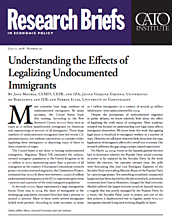The United States is not alone in hosting undocumented immigrants. Migration Watch UK estimated the undocumented immigrant population in the United Kingdom to be 1.1 million in 2010, representing more than 13 percent of all immigrants in the country. A European Commission research project on undocumented migration, the Clandestino Project, estimated that, in 2008, there were between 1.9 and 3.8 million undocumented immigrants in the EU27, representing between 7 percent and 13 percent of the total immigrant population.
In the early 2000s, Spain experienced a large immigration boom. From 1995 to 2004, the share of immigrants in the working-age population increased from less than 2 percent to around 10 percent. Many of these newly arrived immigrants lacked work permits. According to some accounts, as many as 1 million immigrants—in a country of around 43 million inhabitants—were undocumented by 2004.
Despite the prominence of undocumented migration in public debates, we know relatively little about the effect of legalizing the work status of immigrants. Most academic research has focused on understanding how legal status affects immigrants themselves. We know from this work that gaining legal status is beneficial to immigrant workers in a number of ways. However, we still know relatively little about how the mass legalization of immigrants affects the overall host economy. Our research addresses this gap using a unique natural experiment.
On March 14, 2004, voters in the Spanish general election had to determine whether the Popular Party would continue in power or be replaced by the Socialist Party. In the week before the election, the outcome seemed clear: the polls were forecasting that José Luis Rodríguez Zapatero of the Socialist Party was trailing Mariano Rajoy of the Popular Party by 7 percentage points. Yet something completely unexpected happened just three days before the election which, as shown by economist José García-Montalvo, changed the final outcome: Madrid suffered the largest terrorist attack in Spanish history, a tragedy that was poorly managed by the Popular Party. As a result, the Socialist Party came to power, and one of the first policies it implemented was to legalize nearly 600,000 immigrants already living (and working illegally) in Spain.

